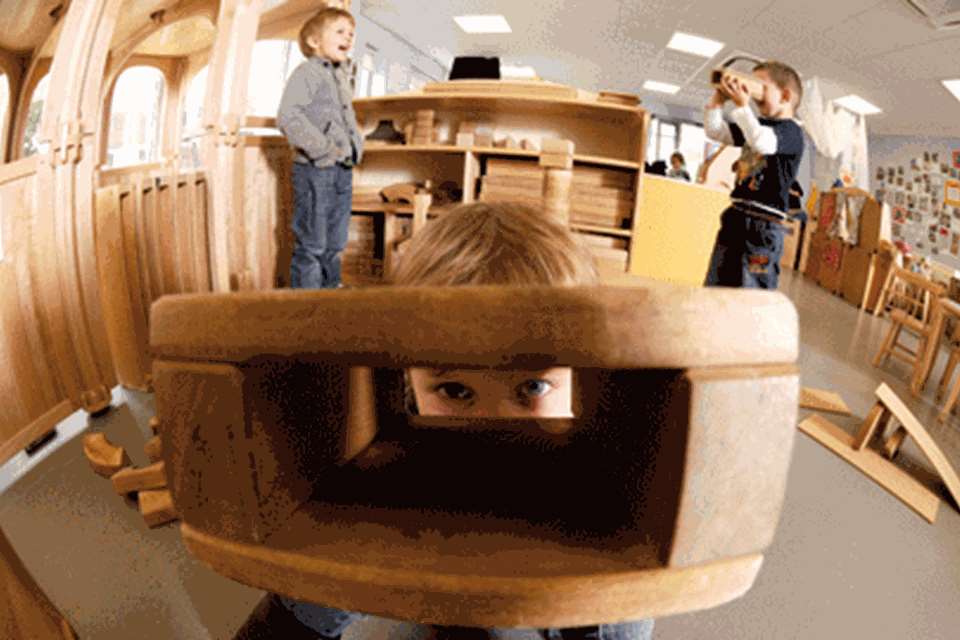Learning & Development: Froebel - Special songs
Sacha Powell, Kathy Goouch and Louie Werth
Monday, December 14, 2015
Singing has a long tradition in nurseries, thanks largely to the work of Friedrich Froebel, and the practice is intimate and complex, explain Sacha Powell, Kathy Goouch and Louie Werth

Walk into a nursery in the UK and the chances are you will hear someone singing with the children. Peep through the window and you’ll see a lot of the singing is accompanied by hand gestures and other actions. We have Friedrich Froebel to thank for the promotion of singing as an educational activity, and songs and finger rhymes as tools to enhance children’s learning experiences. But this is just a glimpse into Froebel’s world, in which he attributed complex meaning and purpose to singing – and, of course, not all singing and all nursery songs convey a Froebelian philosophy.
Froebel spent many years observing and noting children’s songs and games before embarking on his own Mother Songs book. He believed that songs and the closeness involved in the act of singing would help adults and babies to make intimate, emotional connections, and that the babies’ responses within these singing encounters would convey their interests to those caring for them.
MOTHER SONGS
Working with an artist and a music teacher, Froebel wrote poems which his companions then illustrated and set to music: ‘I am not a poet,’ he said, ‘I am an educator… which is the most difficult art of all… but which will not succeed unless it goes hand in hand with poetry, music and the art of drawing.’ (1)
His words give an insight into his views about the rounded and multi-faceted nature of education, the connectedness of educational disciplines, and the role and status of an educator.
Despite its title, Mother Songs offered guidance for teachers and mothers alike since he viewed all adults as educators when they were involved or concerned with caring for young children.
While it may be commonplace to sing to babies and young children in nursery now, singing had not been common in early education in Froebel’s time. Instruction emphasised rote and repetitious learning in which a knowing teacher filled up unknowing children with facts.
Froebel argued that learning happened through children, reflecting his view (which was highly radical in his time) that education was a means to help a child’s inner capacity and potential to unfold with observation- and reflection-based adult nurturance.
Froebel wanted adults to spend time watching and thinking carefully about what babies and children were doing, about how observations demonstrated the connections between children’s inner intellectual, spiritual and emotional selves and the world around them, and their attempts to unite these harmoniously. Through close attention, adults could then work to become closely connected to the children, based on a respectful and trusting emotional bond(2). Froebel’s songs were intended to nurture this bond.
Singing helps adults to closely connect with the children in their care
ROLE AND PLACE
Since 2014, the Froebel Trust has supported our studies into the role and place of singing with babies and toddlers in a small sample of early years settings in southeast England. Our work explores what, when, where and how singing happens, and asks baby room practitioners to help us understand why it happens, from their point of view.
Twenty-nine baby room practitioners and some of their supervisors and managers have joined research and professional development sessions at Canterbury Christ Church University. They have been filmed in the nursery and then reviewed, narrated and discussed their films in individual interviews and in group sessions. Together we have created an audit of the songs and the singing activities happening in their baby rooms. We have found that a catalogue of ‘good’ songs are commonly known and sung across their nurseries.
Many are learnt in childhood or become part of the practitioners’ song repertoires when they begin their nursery careers, learning from more experienced colleagues. Songs perceived as ‘good’ are passed on through generations and are characterised by rhyme and repetition, an upbeat tempo and accompanying actions. Primarily, singing is explained as a device to promote language development, to encourage babies and toddlers to join in and to enliven the atmosphere of a room.
The similarity in the repertoires of songs was striking even though some modifications such as new verses may sculpt traditional versions to fit local circumstances or as a creative response to a baby’s activities at a particular time.
The project sessions offered a space to think about song choices and to compare notes with staff from other nurseries. Many lively discussions ensued, with comments such as, ‘Because we do it every day, all day, you kind of don’t know why you do it.’
INTIMACY AND STILLNESS
The reasons given for singing included the intention to calm babies, but very few songs named might obviously constitute lullabies, although occasionally an otherwise jolly song might be sung/hummed in a slow, quiet way and so it came to represent a lullaby through the intention to soothe and lull. But we encountered two major issues associated with lullabies: intimacy and stillness. In this article we will focus on the first. (Stillness is discussed in our forthcoming report)(3).
Discussions of intimacy began with the word itself, which was roundly rejected by all but one of the practitioners as a word that they felt had risky connotations and was not one they wanted to use to describe their work. Acceptable alternatives were ‘closeness’ and ‘special moments’.
But the discussions about the characteristics of singing with babies and the reasons it may or may not be described as ‘intimate’ also revealed deeply complex issues concerned with the function of emotions that are embedded within singing practices and the emotional messages and connections with the babies that are conveyed through singing. A quotation from Froebel provoked heated discussion: ‘As the little play goes on, you begin to sing; and love, the melody of the heart, is revealed in the melody of the voice.’(4)
HOME FROM HOME
The idea of forming strong emotional bonds with a baby through singing (which we had suggested might be termed ‘intimacy’) was troublesome for a variety of reasons. First, there was a reticence to develop any partiality towards a particular child – despite the differentiated relationships implied by the Key Person Approach – because this challenged ideas about equality.
Second, the provision of ‘home-from-home’ or ‘homely’ environments were said to be promoted and we debated the homogenising assumptions that lie behind these expressions by asking, ‘Whose home?’
When challenged, responses referred to the physical features of the environment rather than a replication of the emotional aspects. Mostly, the practitioners did not want to see themselves as ‘substitute mothers’ in intimate emotional terms.
The idea of trying to recreate the emotional bond between parent and child by mirroring what happens at home created some anxiety. For example, most argued that it would be wrong to try to sing in the nursery a ‘special’ lullaby that parents sang to their babies at home because it was too personal to the family and should not be shared. But they agreed that it would be appropriate to develop their own special song for lulling a baby to sleep at the nursery.
Although there was general approval of the practice of singing these special songs (and perhaps the associated emotional connections these implied and might develop), there was resistance to any suggestion that this substituted for the parents where substitute might mean replace rather than replicate their actions.
These practitioners chose what to sing, how, when and where, even though some also told us that sometimes they would burst into song or realise they were singing unconsciously. But their conscious efforts to refrain from stepping over the invisible line, as they perceived it, to adopt a substitute parent role suggested that their caring behaviours were mediated by their belief that they should be performing a subtly different emotional role from parents (whose behaviours, they said, were ‘natural’).
The exception was if they believed a baby lacked emotional warmth at home, and this provided an outlet for ‘compensating’ in the nursery; but this opened up complex debates about idealising motherhood.
CLOSE RELATIONSHIPS
In the 2010 comprehensive review of research evidence about quality of early childhood care and education for children from birth to three, it is argued that, ‘Infants enter the world with a drive to be near familiar people and to seek close, emotionally satisfying and engaging relationships. Their learning takes place within those close relationships; the intimate interactions between a young child and his carer/s form the foundations of cognitive development, and for the developing sense of self, including self awareness, social awareness, self-regulation and a sense of agency.’(5)
Our study of the role and place of singing has uncovered some complex ideas that play out in navigating the nature and function of emotional relationships and the implications for how a group of practitioners view themselves and the work of caring for babies and young children.
Froebel’s 19th-century ideas about singing in childcare and early education provided a vital mechanism for provoking rich discussions about contemporary professional identities. Undoubtedly, singing remains at the heart of idealised nursery practice, and the value of connectedness to babies’ families is upheld. But the space in between is fraught with tension and complexity that requires time in professional lives to be articulated and held up for personal scrutiny.
Professor Sacha Powell is director of the Research Centre for Children, Families and Communities; Dr Kathy Goouch is professor of education; and Louie Werth is a former Childhood Studies student, all at Canterbury Christ Church University
More Information
1. Cited in Liebschner, J (1992) A Child’s Work. Freedom and Guidance in Froebel’s Educational Theory and Practice. Cambridge: Lutterworth Press.
2. Tovey, H (2012) Bringing the Froebel Approach to Your Early Years Practice. Abingdon: Routledge.
3. Powell, S and Goouch, K (2015) Report to the Froebel Trust on the Mothers’ Songs Project. London: The Froebel Trust, www.froebeltrust.org.uk
4. Froebel, F (1895) in [trans] Blow, H and Blow, S (2003) The Mottoes and Commentaries of Friedrich Froebel’s Mother Play. Stockton, CA: University Press of the Pacific.
5. Mathers, S et al (2010) Sound Foundations. A Review of the Research Evidence on Quality of Early Childhood Education and Care for Children Under Three. Implications for Policy and Practice. London: The Sutton Trust.
NW SHOW 2016
Prof Tina Bruce CBE, a trustee of the Froebel Trust, will be discussing ‘best practice’ and the Froebel tradition in a masterclass on ‘Early Years in Schools’ at the Nursery World Show on 6 February. See: www.nurseryworldshow.com/masterclass/early-years-provision-in-schools-policy-and-practice/87566








